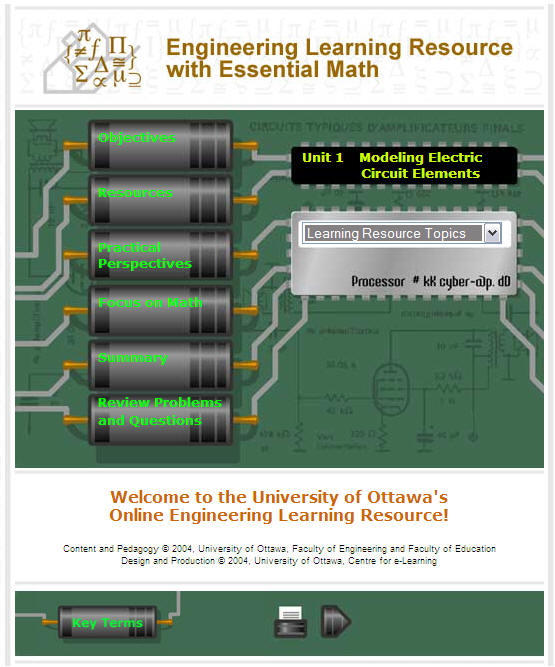|
Part 1: Electric Circuit Theory and Analysis |
|
January 11 |
Lab: Make Lab
Teams (3 Students, Each):
General Instructions;
Introductory Session;
Introductory 2 |
|
January 12 |
Lecture:
Introduction; Chapter 2: Ohm's law, KVL, KCL |
|
January 14 |
Lecture:
Chapter 2:
Read all Examples (2.1-2.14) |
|
|
|
January 18 |
Lab 1: (Simulation: Multisim and Hands-on) Experiment 1:
Multisim work should be submitted
Simulation
Exercises Using MULTISIM.
Part 1
Simulation
Exercises Using MULTISIM.
Part 2 (Advanced: May not be needed now) |
|
January 19 |
Lecture: Chapter 3
(Read Examples: 3.5)
Nodal and mesh analysis |
|
January 20 |
The University of Ottawa IEEE Student
Branch is organizing an Arduino Workshop. Arduinos will be
provided, as well as few circuit components. No prior experience
required. When: 6:00 pm; Where: SITE 2060 |
|
January 21 |
Lecture:
Solving Problems: 2.32; 2.52; 2.59; 2.66; 2.75;
3.1; 3.3; 3.4; 3.7 |
| |
| January 25 |
Lab 1: (Repeating) Experiment 1; You may start Experiment 2 |
| January 26 |
Test 1 (5%): Chapter 2 and 3;
Examples: 2.1-2.14; 3.6; 3.8; 3.10; Problems: 3.7
(-0.5A, -0.5A); 3.9 (-45.53V, -48.69V, 1.31V, 491mA); 3.11
(3.75A); 3.18 (3.89V); 3.26 (8.89V) |
| January 28 |
Invited Presentations; DGD on
AC Circuits |
| |
| February 01 |
Lab 1: Completing Experiment 1 and
Project Work (Step 1: Problem Definition) |
| February 02 |
Lecture: AC Circuits; (Examples 4.14;4.16;4.17;4.18;4.20);
Tutorials 1;
2 (4.54; 4.55; 4.56; 4.57;4.60) |
| February 04 |
Lecture:
Activity on Charging AC Circuit; Solve:
4.56; 4.57; 7.28; 7.31); Fifth Edition of Rizzoni (Solutions) |
| |
| February 08 |
Lab 2: Submission of Lab Report 1;
Experiment 2; Introduction to Lab 2 |
| February 09 |
Lecture: AC Power (7.1, 7.2)
Chapter 7 ; Examples: 7.1-7.11:
Activity on Apparent Power;
Activity on Complex Power;
Activity on Power Factor |
| February 11 |
Midterm 1:
Chapters 2, 3, 4 (P4.56;
4.57), and 7 (Examples 7.1-7.11). |
|
2016 Course Project Theme: 20%+++
Greening Engineering
by Design
Mechatronics to Innovation: Mechanical + Control
+ Electronics + Communication + Software +++
Project Team: 3 Mechanical Engineering Students + ELG
Student as a consultant
Group Meetings: Timed and Minutes Should be Taken.
Tools: Simulation
Softwares; Rapid Prototyping (3D Printing); and/or Machining.
ELG2336 Requirements: Idea + Design
Deliverables: Report + Poster/Video + Simulation
Demonstration by the end of the semester.
Proposal: Title, Group Members, Goals, Brief Design,
Milestones and Time Line by February 22, 2016.
You may adopt one or more of the following
Green Engineering principles
|
Hazards |
Designers
should ensure that all inputs and
outputs are nonhazardous. |
|
Treatment |
Designers should
prevent waste rather than treating or
cleaning up waste. |
|
Consumption |
Designers
should minimize energy and material
consumption. |
|
Efficiency |
Designers should
always aim to maximize efficiency. |
|
Complexity |
Designers
should view easing complexity as an
investment. |
|
Durability |
Designers should
targeted durability as a goal. |
|
Material |
Designers
should minimize
material
diversity. |
|
Renewable |
Designers
should consider renewable energy sources
rather than depleting. |
|
Commercial |
Designers
should consider
performance in a commercial domain. |
Visit the Faculty's
MakerSpace
Learn Circuit Theory Online

See Examples of Student Projects at

|
| Part 2: Electric Machines |
| February 22 |
Experiment 2; Introduction to Lab 2 |
| February 23 |
Engineering Design: Important Instruction for Projects;
Project
Proposal Template |
| February 25 |
Chapter 18 (Magnetic
Circuits): 18.1; 18.2; 18.5; Examples: 18.2; 18.3; 18.4;
18.7 |
| February 29 |
Lab 3: Lab 3: (Hands-on): Experiment 3;
Send Your Project Proposal to your TA and
Course Professor |
| March 01 |
Tutorial on
Magnetic
Circuits |
| March 03 |
DC Machines: Read Examples 19.1-19.7
Armature reaction;
Basic DC motor construction;
Fundamental DC motor;
The DC motor;
Series motor;
Shunt motor; Example 19.6;
Example 19.7; Example 19.8. |
| March 07 |
Lab 3: Lab 3: (Hands-on): Experiment 3 |
| March 08 |
Tutorial on DC Machines |
| March 10 |
AC Three Phase
System: Star and Delta Configuration
AC Synchronous
Machines: Chapter 19 (19.5-19.6) (Examples
19.10-19.11):
The AC Generator;
Synchronous motors |
| March 14 |
Lab: Project Work and Submission of Exp 3 Report. |
| March 15 |
Tutorial on DC and
Synchronous Machines |
| March 17 |
Induction
Machines: Chapter 19 (19.8):
Induction Machines Ch17;
Induction motor slip;
Stator field;
The wound rotor motor;
Torque of induction motor;
Induction Machines Ch17
Electric Utility
Ch18 |
| March 21 |
Lab: Project
Progress |
| March 22 |
Invited Presentation on Wind Turbine
Project; Induction Machines |
| March 24 |
DGD on Induction Machines |
| March 29 |
Chapter 20 (20.1, 20.2, 20.4, 20.5) (No Examples);
Motor Selection Criteria (Problem 20.30)
Special Motors;
|
| March 31 |
Test 2 (Examples 19.6; 19.7; 19.8;
19.10; 19.11; 19.12; 19.13. See the
Tutorial |
| April 04 |
Lab: Project
Progress |
| April 05 |
Review |
| April 07 |
Midterm 2:
Case Study
(Print out the 4-sheet case study, you may write equations at
the back side of the sheets, bring the sheets in order to answer
the remaining two questions of the midterm). |
| April 11 |
Project Design Demonstration:
Solidworks; specifications, etc. You may slides for the
demonstration |
| April 22 |
Project Poster
Exhibition: SITE Cafeteria at 10:00 am.
Use
36" * 48" Presentation Display Board |
| April 22 |
Final Exam |
| |
utorial:
SIMULINK) (Solution) |


